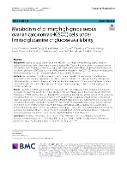| dc.contributor.author | Šimčíková, Daniela | |
| dc.contributor.author | Gardáš, Dominik | |
| dc.contributor.author | Pelikán, Tomáš | |
| dc.contributor.author | Moráň, Lukáš | |
| dc.contributor.author | Hruda, Martin | |
| dc.contributor.author | Hložková, Kateřina | |
| dc.contributor.author | Pivetta, Tiziana | |
| dc.contributor.author | Hendrych, Michal | |
| dc.contributor.author | Starková, Júlia | |
| dc.contributor.author | Rob, Lukáš | |
| dc.contributor.author | Vaňhara, Petr | |
| dc.contributor.author | Heneberg, Petr | |
| dc.date.accessioned | 2024-12-19T12:40:49Z | |
| dc.date.available | 2024-12-19T12:40:49Z | |
| dc.date.issued | 2024 | |
| dc.identifier.uri | https://hdl.handle.net/20.500.14178/2767 | |
| dc.description.abstract | BackgroundHigh-grade serous ovarian carcinoma (HGSOC) is the most common and aggressive subtype of epithelial ovarian carcinoma. It is primarily diagnosed at stage III or IV when the 5-year survival rate ranges between 20% and 40%. Here, we aimed to validate the hypothesis, based on HGSOC cell lines, that proposed the existence of two distinct groups of HGSOC cells with high and low oxidative phosphorylation (OXPHOS) metabolism, respectively, which are associated with their responses to glucose and glutamine withdrawal.MethodsWe isolated and cultivated primary cancer cell cultures from HGSOC and nontransformed ovarian fibroblasts from the surrounding ovarium of 45 HGSOC patients. We tested the metabolic flexibility of the primary cells, particularly in response to glucose and glutamine depletion, analyzed and modulated endoplasmic reticulum stress, and searched for indices of the existence of previously reported groups of HGSOC cells with high and low OXPHOS metabolism.ResultsThe primary HGSOC cells did not form two groups with high and low OXPHOS that responded differently to glucose and glutamine availabilities in the cell culture medium. Instead, they exhibited a continuum of OXPHOS phenotypes. In most tumor cell isolates, the responses to glucose or glutamine withdrawal were mild and surprisingly correlated with those of nontransformed ovarian fibroblasts from the same patients. The growth of tumor-derived cells in the absence of glucose was positively correlated with the lipid trafficking regulator FABP4 and was negatively correlated with the expression levels of HK2 and HK1. The correlations between the expression of electron transport chain (ETC) proteins and the oxygen consumption rates or extracellular acidification rates were weak. ER stress markers were strongly expressed in all the analyzed tumors. ER stress was further potentiated by tunicamycin but not by the recently proposed ER stress inducers based on copper(II)-phenanthroline complexes. ER stress modulation increased autophagy in tumor cell isolates but not in nontransformed ovarian fibroblasts.ConclusionsAnalysis of the metabolism of primary HGSOC cells rejects the previously proposed hypothesis that there are distinct groups of HGSOC cells with high and low OXPHOS metabolism that respond differently to glutamine or glucose withdrawal and are characterized by ETC protein levels. | en |
| dc.language.iso | en | |
| dc.relation.url | https://doi.org/10.1186/s40170-024-00355-1 | |
| dc.rights | Creative Commons Uveďte původ-Neužívejte dílo komerčně-Nezpracovávejte 4.0 International | cs |
| dc.rights | Creative Commons Attribution-NonCommercial-NoDerivativeWorks 4.0 International | en |
| dc.title | Metabolism of primary high-grade serous ovarian carcinoma (HGSOC) cells under limited glutamine or glucose availability | en |
| dcterms.accessRights | openAccess | |
| dcterms.license | https://creativecommons.org/licenses/by-nc-nd/4.0/legalcode | |
| dc.date.updated | 2025-01-05T12:40:47Z | |
| dc.subject.keyword | Epithelial ovarian carcinoma | en |
| dc.subject.keyword | Metabolism reprogramming | en |
| dc.subject.keyword | Ovarian fibroblasts | en |
| dc.subject.keyword | Oxidative phosphorylation | en |
| dc.subject.keyword | Patient-derived cells | en |
| dc.subject.keyword | Unfolded protein response | en |
| dc.subject.keyword | | en |
| dc.identifier.eissn | 2049-3002 | |
| dc.relation.fundingReference | info:eu-repo/grantAgreement/UK/GAUK/GAUK324421 | |
| dc.relation.fundingReference | info:eu-repo/grantAgreement/UK/COOP/COOP | |
| dc.date.embargoStartDate | 2025-01-05 | |
| dc.type.obd | 73 | |
| dc.type.version | info:eu-repo/semantics/publishedVersion | |
| dc.identifier.doi | 10.1186/s40170-024-00355-1 | |
| dc.identifier.utWos | 001314036200001 | |
| dc.identifier.obd | 653149 | |
| dc.identifier.pubmed | 39285269 | |
| dc.subject.rivPrimary | 30000::30200::30204 | |
| dcterms.isPartOf.name | Cancer & Metabolism | |
| dcterms.isPartOf.issn | 2049-3002 | |
| dcterms.isPartOf.journalYear | 2024 | |
| dcterms.isPartOf.journalVolume | 12 | |
| dcterms.isPartOf.journalIssue | September | |
| uk.faculty.primaryId | 110 | |
| uk.faculty.primaryName | 3. lékařská fakulta | cs |
| uk.faculty.primaryName | Third Faculty of Medicine | en |
| uk.faculty.secondaryId | 109 | |
| uk.faculty.secondaryName | 2. lékařská fakulta | cs |
| uk.faculty.secondaryName | Second Faculty of Medicine | en |
| uk.department.primaryId | 110 | |
| uk.department.primaryName | 3. lékařská fakulta | cs |
| uk.department.primaryName | Third Faculty of Medicine | en |
| uk.department.secondaryId | 1675 | |
| uk.department.secondaryId | 633 | |
| uk.department.secondaryId | 619 | |
| uk.department.secondaryName | Klinika dětské hematologie a onkologie | cs |
| uk.department.secondaryName | Klinika dětské hematologie a onkologie | en |
| uk.department.secondaryName | Interní klinika 3. LF UK a FNKV | cs |
| uk.department.secondaryName | Department of Internal Medicine 3FM CU and UHKV | en |
| uk.department.secondaryName | Gynekologicko-porodnická klinika 3. LF UK a FNKV | cs |
| uk.department.secondaryName | Department of Gynecology and Obstetrics 3FM CU and UHKV | en |
| dc.type.obdHierarchyCs | ČLÁNEK V ČASOPISU::článek v časopisu::původní článek | cs |
| dc.type.obdHierarchyEn | JOURNAL ARTICLE::journal article::original article | en |
| dc.type.obdHierarchyCode | 73::152::206 | en |
| uk.displayTitle | Metabolism of primary high-grade serous ovarian carcinoma (HGSOC) cells under limited glutamine or glucose availability | en |

